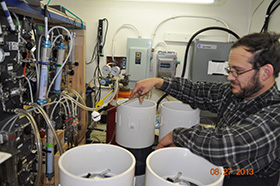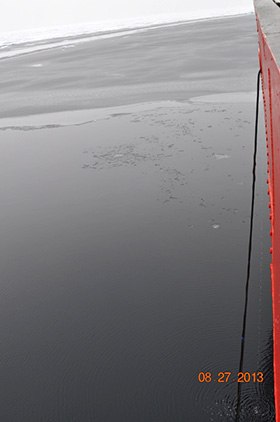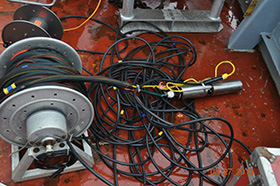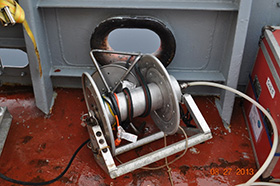B. Loose and R.P. Kelly, URI Graduate School of OceanographyAugust 28, 2013One group from the URI Graduate School of Oceanography is measuring radon-222 to estimate how gas passes between the ocean and the atmosphere, with sea ice in the way. Here is that story. If at some time in your life you lived in a home with a basement, then its likely that you have heard of radon, and probably, you got the impression that radon was not something you wanted in your home. Discovering radon in the basement is not greeted with the same enthusiasm as discovering gold coins or priceless antiques, but the problem has a pretty simple solution. Radon-222 is a radioactive gas produced by the decay of its parent, radium-226. Radium-226 occurs naturally in different rock types and in some regions the amount of radium in the soil is enough to produce dangerous levels of radon gas inside a closed space (usually in the basement). When radon decays it emits alpha particles, and exposure to these particles are not good for human health. For this reason, radon sampling in residential homes has been a common practice for at least 50 years. If the home had excessive levels of radon, then the most common practice is to make sure the basement and first floor of the home are well ventilated with outside air. There is almost no radon in the atmosphere, so this takes care of the problem. Radon is also produced in the ocean’s basement. Radium finds its way into the water through contact with river-borne particles and deep ocean sediments. One can go anywhere in the ocean and measure detectable levels of radon and radium, if you collect enough water! Radon has a half-life of 3.8 days; that is, whatever amount you have (or halve) will be half gone after 3.8 days. Because we know radon’s half-life so well, it is very useful as a clock for ocean processes. In this case, we use radon as a flux clock to figure out how much gas exchanges between the water and the air. To understand how radon is used as a flux clock, consider a bottle of beer, but imagine for a second that the beer has a little sediment in it and that sediment contains radium. Before the top is taken off the bottle, the beer inside is not exchanging with the air. Radon is being produced from radium and is decaying with a half-life of 3.8 days. In this closed bottle the amount of radon will be directly proportional to the amount of radium. This proportionality is known as secular equilibrium. Next, remove the top from the beer –bubbles form as the gas escapes to the air. The surface ocean is like the bottle of beer. When ice caps the surface, radon cannot escape and the ocean surface will be in secular equilibrium. However, when some or all the ice is removed then radon will escape to the air. This means radon is no longer in equilibrium with radium, and the “deficit” in radon below secular equilibrium gives us the rate of air-sea gas exchange. In the open ocean, the rate of air-sea exchange is much better understood, but sea ice complicates the picture because it blocks the flow, but it also stirs the water. These two processes – blocking and stirring – have opposing effects on gas exchange. So, the goal of this study is to measure the rate of exchange and relate it to the amount and type of sea ice covering the ocean surface. Tales from the foredeck: The JOIS cruises are famous for multi-tasking; that is, they try to do as much science as possible in the time aboard the ship. Science operations happen 24 hours a day, 7 days a week and when we pull up to a hydrographic station, the ship will extends its cabled instruments, like tentacles, and the measurements commence! The JOIS science team will dangle no less than five instrument packages in the water and some of these happen at the same time. With so many cables in the water, care has to be taken not to end up with a tangled mess. But each group has a radio and they all coordinate through the all-seeing all-knowing Bridge, which sits 30 feet above the science deck and watches for ice, bears and safe behavior on deck. The JOIS radon lab is bolted to the foredeck of the Louis, between the bow and the Bridge. Sure, it is windier and bouncier up there, but we need the space because we need to sample a lot of water. When we sample for radon, we lower a pump over the side of the ship to the water 30 feet below and pump the surface water aboard. If we want to go deeper then we can use the foredeck rosette to take bottle samples. The abundance of radon is so meager in these open ocean samples that we have to collect a lot of water – 20 to 30 liters. We fill our pre-evacuated sample containers – known as Keyblers – with 20 to 30 liters of water. For a complete water-column picture, 20-30 liters are taken from multiple depths to determine the upper ocean radon abundance. Sometimes we get greedy and then we fill a barrel with 200 L to look for the less abundant isotopes of radium (224, 223, and 228). After the samples come aboard, the real fun begins. The water is stripped of radon gas by bubbling with helium. We freeze the radon onto a trap using dry ice at -78 °C and then boil it off the trap onto a counting cell at 450 °C. The cell has a coating of zinc sulfide, which gives off three photons for every atom of radon that decays within the cell. We count the number of photons emitted by each cell, and hence the amount of radon from the sample, using a photomultiplier tube. Finally, after we’re done counting, we clean the cell by sucking out the radon with a vacuum and rinsing the cell with helium. All this takes between 18 and 24 hours to complete. We sleep in 3-hour blocks while waiting for the counts to add up, then clean up the counting cells and get ready to for the next station. We try to sample one station per day. To accomplish one radon cast requires 15 cups of coffee (7.5 per person). Having completed 20 stations, this adds up to 350 cups of coffee! A radon deficit equals a caffeine surplus. Fortunately, the galley has coffee 24 hours a day, just like a floating 7-11 (galley coffee is better, though). Last updated: October 7, 2019 | |||||||||||
Copyright ©2007 Woods Hole Oceanographic Institution, All Rights Reserved, Privacy Policy. | |||||||||||






